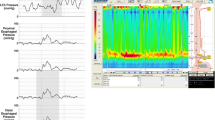Abstract
Clinical and manometric data from 13 elderly subjects with idiopathic achalasia (mean age 79±2 years) were compared with findings from younger subjects with the same disease (n=79) to see if aging altered the presentation and outcome of this motor disorder. Fewer elderly subjects complained of chest pain (27% vs 53%), and the pain was significantly less severe (P<0.01). Other presenting features (including sex, duration of symptoms, and presence and severity of dysphagia) did not differ between the groups. Across all patients, age weakly and inversely correlated with residual postdeglutitive lower esophageal sphincter (LES) pressure (R=−0.34), and residual pressure was significantly lower in the older subjects (8.0±1.3 mm Hg vs 11.9±0.8 mm Hg;P=0.02). No differences in basal LES pressure or esophageal-body contraction amplitudes were present between the groups. Initial success with pneumatic dilation was similar in the two subject groups, but the number of older subjects available for analysis was too small to draw strong conclusions. These results indicate that aging decreases the elevation of LES residual pressure that occurs with achalasia. As elderly achalasia patients also present with less chest pain, the findings may be interrelated.
Similar content being viewed by others
References
Mayberry JF, Atkinson M: Studies on the incidence and prevalence of achalasia in the Nottingham area. Q J Med 56:451–456, 1985
Cassella RR, Brown AL Jr, Sayre GP, Ellis FH Jr: Achalasia of the esophagus: Pathologic and etiologic considerations. Ann Surg 160:474–487, 1964
Almy TP: Alterations in gastrointestinal function in old age.In Principles of Geriatric Medicine. R Andres, EL Bierman, WR Hazzard (eds). New York, McGraw-Hill, 1985, pp 297–310
Todorczuk JR, Abramson BK, Clouse RE: Reevaluation of manometric criteria for vigorous achalasia: Is this a distinct clinical disorder? Gastroenterology 1990 (abstract) (in press)
Reidel WL, Clouse RE: Variations in clinical presentation of patients with esophageal contraction abnormalities. Dig Dis Sci 30:1065–1071, 1985
Clouse RE, Staiano A: Contraction abnormalities of the esophageal body in patients referred for manometry: A new approach to manometric classification. Dig Dis Sci 28:784–791, 1983
Aliperti G, Clouse RE: Incomplete lower esophageal sphincter (LES) relaxation in subjects without aperistalsis: Prevalence and clinical outcome. Gastroenterology 96:A6, 1989
Barrett NR: Achalasia of the cardia: Reflections upon a clinical study of over 100 cases. Br Med J 1:1135–1140, 1964
Kramer P, Ingelfinger FJ: Esophageal sensitivity to mecholyl in cardiopasm. Gastroenterology 19:242–251, 1951
Heitmann P, Espinoza J, Csendes A: Physiology of the distal esophagus in achalasia. Scand J Gastroenterol 4:1–11, 1969
Dodds WJ, Dent J, Hogan WJ, Patel GK, Toouli J, Arndorfer RC: Paradoxical lower esophageal sphincter contraction induced by cholecystokinin-octapeptide in patients with achalasia. Gastroenterology 80:327–333, 1981
Csendes A, Smok G, Braghetto I, Ramirez C, Velasco N, Henriques A: Gastroesophageal sphincter pressure and histological changes in the distal esophagus in patients with achalasia of the esophagus. Dig Dis Sci 30:941–945, 1985
Szurszewski JH, Holt PR, Schuster MM: Proceedings of a workshop entitled “Neuromuscular function and dysfunction of the gastrointestinal tract in aging”. Dig Dis Sci 34:1135–1146, 1989
Soergel KH, Zboralske FF, Amberg JR: Presbyesophagus: Esophageal motility in nonagenarians. J Clin Invest 43:1472–1479, 1964
Richter JE, Wu WC, Johns DN, Blackwell JN, Nelson JL III, Castell JA, Castell DO: Esophageal manometry in 95 healthy adult volunteers: variability of pressures with age and frequency of “abnormal” contractions. Dig Dis Sci 32:583–592, 1987
Horowitz M, Maddern GJ, Chatterton BE, Collins PJ, Harding PE, Shearman DJ: Changes in gastric emptying rates with age. Clin Sci 61:213–218, 1984
Moore JG, Tweedy C, Christian PE, Datz FL: Effect of age on gastric emptying of liquid-solid meals in man. Dig Dis Sci 28:340–344, 1983
Wong RKH, Johnson LF: Achalasia.In Esophageal Function in Health and Disease. DO Castell, LF Johnson (eds). New York, Elsevier Biomedical, 1983, pp 99–123
Kaye MD: Anomalies of peristalsis in idiopathic diffuse oesopahgeal spasm. Gut 22:217–222, 1981
Robertson CS, Fellows IW, Mayberry JF, Atkinson M: Choice of therapy for achalasia in relation to age. Digestion 40:244–250, 1988
Author information
Authors and Affiliations
Additional information
Supported in part by grant AMO7130 from the United States Public Health Service. Dr. Todorczuk is supported by an educational grant from Smith, Kline, and French.
Rights and permissions
About this article
Cite this article
Clouse, R.E., Abramson, B.K. & Todorczuk, J.R. Achalasia in the elderly. Digest Dis Sci 36, 225–228 (1991). https://doi.org/10.1007/BF01300761
Received:
Revised:
Accepted:
Issue Date:
DOI: https://doi.org/10.1007/BF01300761




